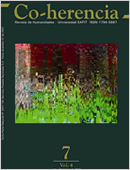The analysis of the organization of literary discourse in Spanish.
Main Article Content
Keywords
Literary discourse, Systemic Functional Linguistics, Theme, Method of development.
Abstract
This work illustrates the heuristic potential of Systemic Functional Linguistics for analyzing the organization of literary discourse in Spanish. It is based on a systemic-functional and discursive view of Theme considered as the succession of points of departure chosen to construe text, which represent its ‘Method of Development’. The analysis is based on a corpus taken from Gabriel García Márquez and Jorge Luis Borges to examine the concepts of marked Theme and unmarked Theme for Spanish. It also illustrates the notions of hyperTheme, the first clause of a paragraph, and macroTheme, the point of departure of a whole text. These insights on the concept of Theme allow for a deeper understanding of the organization of discourse.
Downloads
References
Berry, Margaret (1995) “Thematic options and success in writing (revised)”. In:Ghadessy, M. (ed.) Thematic Development in English Texts. London and New York,Pinter, pp. 55-84.
Berry, Margaret (1996) “What is Theme? A(nother) Personal View”. In: Berry,M.; Butler, C.; Fawcett, R.; Huang, G. (eds.) Meaning and Form: Systemic FunctionalInterpretations - Meaning and Choice in Language: Studies for Michael Halliday. NewJersey, Ablex Publishing, pp. 1-64.
Chafe, Wallace (1994) Discourse, Consciousness, and Time. Chicago and London,The University of Chicago Press.
Cucatto, Andrea (2004) La Tematización en español. Un estudio pragmático (tesisdoctoral). Facultad de Humanidades y Ciencias de la Educación, Universidad Nacional de La Plata.
Di Tullio, Ángela (1997) Manual de gramática del español. Buenos Aires, Edicial.
Davies, Florence (1988) “Reading between the lines: Thematic choice as a devicefor presenting written viewpoint in academic discourse”. In: ESPecialist 9, 1/2, pp.173-200.
Davies, Florence (1997) “Marked Theme as a heuristic for analysing text-type, textand genre”. In: Pique, J. and Viera, D.J. (eds.) Applied Linguistics: Theory and Practicein ESP. Valencia University Press, pp. 45-79.
Firbas, Jan (1992) Functional sentence perspective in written and spoken communication. Cambridge University Press.
Fries, Peter (1983) “On the status of Theme in English: arguments for discourse”.In: Petöfi, J.S. and Sozer, E. (eds.) Micro and Macro Connexity of Texts.Hamburgo,Helmut Buske, pp. 116-152.
Fries, Peter (1995) “Themes, methods of development, and texts”. In: Hasan,R. and Fries, P. (eds.) On Subject and Theme: A Discourse Functional Perspective. Amsterdam, John Benjamins, pp. 311-328.
Halliday, Michael (1985/1994) An Introduction to Functional Grammar. London -New York, Edward Arnold.
Halliday, Michael y Matthiessen, Christian (2004) An Introduction to Functional Grammar. London - New York, Edward Arnold.
Martin, Jim (1985) Factual writing: exploring and challenging social reality. Oxford University Press.
Martin, Jim (1992) English Text: System and Structure. Amsterdam, John Benjamins.
Martin, Jim; Matthiessen, Christian and Painter, Clare (1997) Working withFunctional Grammar. London y Nwe York, Edward Arnold.
Martin, Jim y Rose, David (2003) Working with Discourse: Meaning beyond theclause. London and New York, Continuum.
McCabe, Anne (1999) Theme and thematic patterns in Spanish and history texts (tesisdoctoral). England, Aston University.
Mendenhall, Vance (1990) Une introduction à l’analyse du discours argumentatif.Les Presses de l’ Université d’ Ottawa.
Montemayor-Borsinger, Ann (2002) Apuntes de lingüística sistémica-funcional: unesquema de análisis dinámico para el español. Instituto de Lingüística, Universidadde Buenos Aires.
Montemayor-Borsinger, Ann (2003) “Ordenamiento Temático en distintos idiomas: análisis dediálogos en la literatura española y su traducción al inglés”.En: Granato, L. (ed.)En torno al diálogo: interacción, contexto y representación social.La Plata, pp. 667-674.
Montemayor-Borsinger, Ann (2005) “La lingüística sistémica-funcional y sus aplicaciones al estudio del discurso en español”. En: Pilleux, M. (ed.) Contextos del discurso. Chile,Frasis, pp. 207-214.
Moreno Cabrera, Juan Carlos (1999) “Las funciones informativas: Las perífrasisde relativo y otras construcciones perifrásticas”. En: Gramática Descriptiva de laLengua Española 3: Entre la oración y el discurso.Madrid, Espasa Calpe, pp. 4245-4303.
Moss, Gillian, Mizuno Haydar, Jorge Miguel, Ávila García, Diana Cecilia, BarlettaManjarrés, Norma Patricia, Carreño de Tarazona, Solange, Chamorro Miranda,Diana Judith, Tapia de Vergel, Carlina (2003) Urdimbre del texto escolar ¿Por quéresultan difíciles algunos textos? Barranquilla, Ediciones Uninorte.
Zubizarreta María Luisa (1998) Prosody, Focus and Word Order.Cambridge, MIT Press.
Zubizarreta María Luisa (1999) “Las funciones informativas: Tema y Foco”. En: Gramática Descriptiva de la Lengua Española 3: Entre la oración y el discurso.Madrid, Espasa Calpe, pp. 4215-4244
Corpus
Borges,Jorge Luis (1949) “Emma Zunz”. En: El Aleph (publicado nuevamente en Obras Completas Tomo I. Buenos Aires, Emecé (1974), p. 568). Traducción alinglés de Donald, Ayas (1964) Londres, Penguin, p. 169.
García Márquez, Gabriel (1970) Relato de un náufrago. Buenos Aires, Sudamericana,p. 163. Traducción al inglés: The Story of a Shipwrecked Sailor. Por Randolph, Hogan.Londres, Penguin (1996), p. 106.
